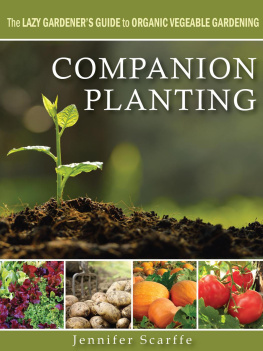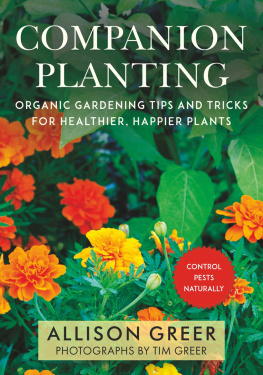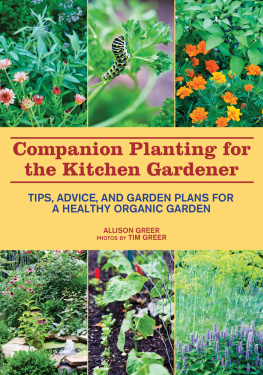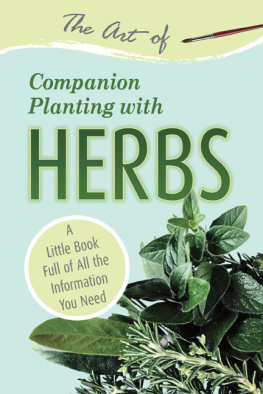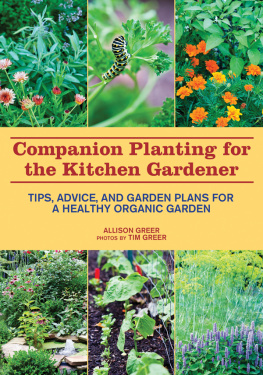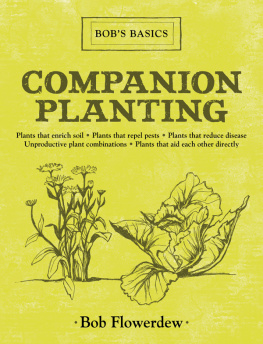CARROTS LOVE TOMATOES
SECRETS OF COMPANION PLANTING FOR SUCCESSFUL GARDENING
Louise Riotte

The mission of Storey Publishing is to serve our customers by
publishing practical information that encourages
personal independence in harmony with the environment.
Edited by Julia Needham and Deborah Burns
Cover design by Meredith Maker
Cover illustration by Linda Devito Soltis
Text design by Cynthia McFarland
Text production by Eileen M. Clawson
Line drawings by the author
Indexed by Susan Olason, Indexes & Knowledge Maps
1975, 1998 by Storey Publishing, LLC
Cover illustration Linda Devito Soltis
All rights reserved. No part of this book may be reproduced without written permission from the publisher, except by a reviewer who may quote brief passages or reproduce illustrations in a review with appropriate credits; nor may any part of this book be reproduced, stored in a retrieval system, or transmitted in any form or by any means electronic, mechanical, photocopying, recording, or other without written permission from the publisher.
The information in this book is true and complete to the best of our knowledge. All recommendations are made without guarantee on the part of the author or Storey Publishing. The author and publisher disclaim any liability in connection with the use of this information. For additional information please contact Storey Publishing, 210 MASS MoCA Way, North Adams, MA 01247.
Storey books are available for special premium and promotional uses and for customized editions. For further information, please call 1-800-793-9396.
Printed in the United States by Versa Press
30 29 28 27 26 25 24 23 22 21 20
Library of Congress Cataloging-in-Publication Data
Riotte, Louise.
Carrots love tomatoes : secrets of companion planting for successful gardening
/ Louise Riotte. 2nd ed.
p. cm.
A Storey Publishing book.
Rev. ed. of : Secrets of companion planting, 1975.
Includes bibliographical references (p. ) and index.
ISBN 978-1-58017-027-7 (alk. paper)
1. Companion planting Dictionaries. 2. Companion crops
Dictionaries. 3. Gardening Dictionaries. 4. Plants, Useful
Dictionaries. I. Riotte, Louise. Secrets of companion planting. II. Title.
S603.5.R56 1998
635 dc21
97-31914
CIP
Table of Contents
Introduction
The magic and mystery of companion planting have intrigued and fascinated humans for centuries, yet it is a part of the gardening world that has never been fully explored. Even today we are just on the threshold. In years to come I hope that scientists, gardeners, and farmers everywhere will work together in making more discoveries that will prove of great value in augmenting the worlds food supply.

Plants that assist each other to grow well, plants that repel insects, even plants that repel other plants all are of great practical use. They always have been, but we are just beginning to find out why. Delving deeply into this fascinating aspect of gardening can provide for us both pleasure and very useful information. I hope that what I have written here will give you many of the tools to work with.
Vegetable growers find that companion planting provides many benefits, one of which is protection from pests. A major enemy of the carrot is the carrot fly, whereas the leek suffers from the onion fly and leek moth. Yet when leek and carrot live together in companionship, the strong and strangely different smell of the partner plant repels the insects so much that they do not even attempt to lay their eggs on the neighbor plant. They take off speedily to get away from the smell. This is why mixed plantings give better insect control than a monoculture, where many plants of the same type are planted together in row after row. Even when plants are affected by diseases, a mixed plant culture can usually alleviate the situation.
It is important to remember that not all protective botanicals act quickly. For example, marigolds, to be effective in nematode control, should be grown over at least one full season, and more is better, for their effect is cumulative. One should also realize that certain companion plants will diminish each others natural repelling ability as they grow together. All through this book you will find what to grow with and what not to grow with. Both are equally important to gardening success.
The effects of plants on one another are important outside the vegetable garden, among trees and shrubs as well as grains, grasses, and field crops. These have chapters to themselves, as do herbs, the group of plants most widely used as protective companions.
Wild plants also play a vital part in the plant community. Some are accumulator plants those that have the ability to collect trace minerals from the soil. They actually can store in their tissues up to several hundred times the amount contained in an equal amount of soil. These plants, many of which are considered weeds, are useful as compost, green manure, or mulch. Some are deep diggers, sending their roots deep into the ground to penetrate hardpan and helping to condition the soil, and some have value as protectors of garden plants.
An entirely different type of community life is that of fruit and nut trees and the bush and bramble small fruits. For many of this group, the choice of good companions is not only helpful but also essential. Have you ever experienced the disappointment of having a beautiful fruit tree blossom, be visited by the bees, and yet fail to bear? There is a reason, of course, and it lies in pollinization. Pollen is the dust from blossoms that is needed to make the plant fruitful. If the tree is self-unfruitful and there is no pollenizer of the correct type growing near, it is doubtful that the tree will ever bear well. In the chapters on fruit and nut growing, Ill attempt to unravel some of this mystery, which seems particularly to plague new gardeners and orchardists.
A note on the chapter devoted to poisonous plants: This information is not meant to frighten but to warn, for most of the nursery catalogs do not tell us which plants are poisonous or to what degree. Even some of the gardening encyclopedias do not.
Cases of death resulting from poisonous plants are rare, but they do happen. In this book I refer to poisonous plants that are useful in the garden for various reasons. It is only fair to tell you that some of those most commonly used may be harmful to children, to livestock, or even to you.
Many of our loveliest and most decorative plants are poisonous oleanders, daffodils, scillas, lily of the valley, hyacinths, and larkspurs. Other equally poisonous plants are of value for medicines or as insect repellents. To know is to be forewarned, and because we know, we may use them safely, for poisonous plants, unlike poisonous insects or animals, are never aggressive. You are in control of them at all times.
All of the suggestions given in this book for companion planting are only a beginning. I have included practical information on soil improvement and garden techniques, as well as some sample garden plans, to help you put companion plants to work for you. Your own experiments will lead you into many exciting pathways and discoveries.



